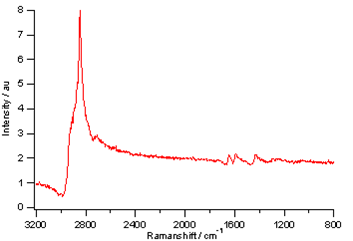Fiscal 2008
(1) Intensity Enhancement and Selective Detection of Proximate Solvent Molecules by Molecular Near-field Effect in Resonance Hyper-Raman (HR) Scattering
A new photo-molecular phenomenon associated with resonance hyper-Raman (HR) scattering in solution has been discovered. Resonance HR spectra of all-trans-β-carotene in four different solvents (cyclohexane, CCl4, benzene, CS2) exhibit several extra bands that are not assignable to the solute but are unequivocally assigned to the solvents (Fig. 1). Neat solvents do not show any detectable HR signal under the same experimental conditions. All-trans-β-carotene has thus been shown to induce enhanced HR scattering of solvent molecules through a novel photo-molecular effect. We call this new effect the gmolecular near-field effecth with analogy to the near-field effect in surface-enhanced Raman scattering. In order to explain this newly found effect, an extended vibronic theory of resonance hyper-Raman scattering is developed where the vibronic interaction including the proximate solvent molecule is explicitly introduced in the solute hyperpolarizability tensor. The possibility of gmolecular near-field HR spectroscopyh, which selectively detects molecules existing in the close vicinity of a HR probe in a complex chemical or biological system, has been demonstrated.

Fig. 1 Hyper-Raman spectra of all-trans-β-carotene in a crystal (top) and in four different solvents (bottom 4). The solvent bands induced by the molecular near-field effect are indicated by arrows.
(2) Ultrabroadband multiplex Coherent anti-Stokes Raman Scattering (CARS) microspectroscopy and imaging using a subnanosecond supercontinuum light source in the deep near infra-red
Ultrabroadband multiplex CARS microspectroscopy has been extended to the deep near-infrared region, in order to facilitate measurements with less photo-damage and larger penetration depth for biological systems like living cells. Subnanosecond (sub-ns) supercontinuum (SC) has been generated by a 1064 nm microchip laser combined with a photonic crystal fiber. The ultrabroadband (> 2000 cm-1) SC has enabled multiplex CARS microspectroscopy in a wide spectral range from 1000 to 3000 cm-1 (Fig. 2). Thanks to the narrow line width of the sub-ns microchip laser, well resolved CARS features are observed in the fingerprint region (Fig. 3) from a single budding yeast cell. Fast CARS spectroscopy (10 ms integration time) and imaging (several seconds) is now possible not only in the CH stretch region but also in the highly congested finger print region.

Fig. 2 Multiplex CARS spectrum from a budding yeast cell.

Fig. 3 Expanded multiplex CARS spectrum from a budding yeast cell in the fingerprint region.
Refereed Journals
- Chikao Onogi; Michiyo Motoyama; Hiro-o Hamaguchi, "High concentration trans form unsaturated lipids detected in a HeLa cell by Raman microspectroscopy", J. Raman Spectrosc. 39, 555-556 (2008).
- Masanari Okuno; Hideaki Kano; Pilippe Leproux; Vincent Courdec; Hiro-o Hamaguchi, "Ultrabroadband multiplex CARS microspectroscopy and imaging using a subnanosecond supercontinuum light source in the deep near infrared", Opt. Lett. 33, 923-925 (2008).
- Koichi Iwata, "Ultrafast bimolecular radical reaction between S1 p-terphenyl and carbon tetrachloride. Mode-specific acceleration of vibrational dephasing in reactant molecule.", J. Raman Spectrosc. 39, 1512-1517 (2008).
- Rintaro Shimada; Hideaki Kano; Hiro-o Hamaguchi, "Intensity enhancement and selectivedetection of proximate solvent molecules by molecular near-field effect in resonance hyper-Raman scattering", J. Chem. Phys. 129, 024505-1-024505-9 (2008).
- Hideaki Kano, "Molecular vibrational imaging of a human cell by multiplex coherent anti-Stokes Raman scattering microspectroscopy using a supercontinuum light source", J. Raman Spectrosc. 39, 1649-1652 (2008) .
- Yoonnam Jeon; Jaeho Sung; Doseok Kim; Chungwon Seo; Hyeonsik Cheong; Yukio Ouchi; Ryosuke Ozawa; Hiro-o Hamaguchi, "Structural change of 1-butyl-3-methylimidazolium tetrafluoroborate plus water mixtures studied by infrared vibrational Spectroscopy", J. Phys. Chem. B 112, 923-928 (2008) .
- Satoshi Naito; Youn-Kun Min; K Sugata; O Osanai; T Kitahara; Hideo Hiruma; Hiro-o Hamaguchi, "In vivo measurement of human dermis by 1064 nm-excited fiber Raman spectroscopy", Skin Research and Technology 14, 18-25 (2008) .
- Yong-Woo Lee; Jong-Kwang Lee; Youn-Kun Min; Hiro-o Hamaguchi; Jinwook Chung, "Development of an automatic phase-contrast microscopic system capable of determining the microbial density and distribution inside an immobilized carrier", Anal. Sci. 24, 547-550 (2008).